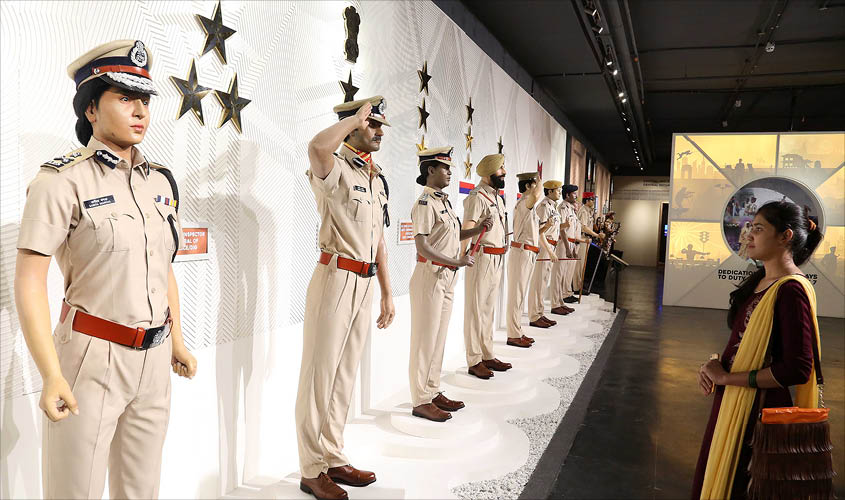An underground museum showcases the growth and development of policing in India since Harappan times.
Prime Minister Narendra Modi inaugurated the National Police Memorial (NPM) here last Sunday on Police Commemoration Day, the day the nation pays homage to all the policemen killed in the line of duty. Besides honouring the martyred policemen from across the country, the memorial houses an underground museum showcasing the growth and development of policing in India since Harappan times.
“A grateful nation pays tributes to all those policemen and policewomen martyred in the line of duty. We salute their families for their fortitude,” PM Modi tweeted hours before the inauguration. “It is the result of your alertness that the elements which create unrest are unsuccessful in their attempts. The attempts to create fear and insecurity in the nation were foiled by you. The peace prevalent in the nation is possible only due to your services,” he added.
Union Home Minister Rajnath Singh, Ministers of State Kiren Rijiju and Hansraj Ahir and the heads of various para-military forces were also present at the inaugural function.
Located in the diplomatic enclave in Chanakyapuri, the memorial is a reminder of the ultimate sacrifice made by the men and women in khaki in defence of the nation. Built on 6.12 acre of area, it represents all state/Union territory (UT) police forces along with the Central police organisations.
The central sculpture of NPM is a 30-feet-tall monolith made of single piece of granite procured from Khammam district of Telangana and weighs 238 tonne. Its design was conceptualised by Adwaita Gandanayak, the Director-General of National Gallery of Modern Art (NGMA).
Its weight and colour symbolise gravitas and solemnity of the supreme sacrifice of the police forces. The sculpture has a 60-foot-long river at its base which reflects the continuous self-service of policemen and women in maintaining peace and public order.
The memorial was a pet project of former Deputy Prime Minister L.K. Advani, who was the Home Minister in the first NDA government. Its construction was halted as Delhi’s Urban Arts Commission had objected to the height of the tower-like memorial which would have been taller than Rashtrapati Bhavan, less than a kilometre away from its location on Shanti Path.
According to Lutyens’ Zone rules, no building should be taller than the maximum tree height on all the symbolic axes radiating from the Presidential palace, and most certainly not higher than its dome. Criticism to the “monstrous” aesthetics of the bell-like structure brought construction to a halt. After lying untouched for a few years, the structure was demolished in 2008, and a new design was selected based on a national competition.
The present one, from the design firm Lotus, envisaged a more horizontal and spread-out approach rather than the previous “tall boy” tower. There are gardens, motifs ranging from the Ashoka Chakra to folded hands, all encircling a central stone epitaph. There is a Wall of Valour engraved with the names of more than 34,000 policemen who have died in service since Independence.
The museum itself is located underground and consists of five galleries over 1,600 square metre. As one enters the long tunnel-like passage going into the museum, one can see the walls displaying the origins and growth of policing in India since ancient times.
Inside there are sections dedicated for various central and state police forces in India including Central Industrial Security Force (CISF), Special Protection Group (SPG), National Security Guard (NSG), Rapid Protection Force (RPF), Bureau of Civil Aviation Security (BCAS), Central Reserve Police Force (CRPF), Indo-Tibet Border Police (ITBP) and Intelligence Bureau (IB).
Police forces from all 30 states and 5 Union territories are presented, including special mention for women squads, police bands and animal squads (camel, dog and pigeon post). The role of police research organisations have also been mentioned such as Bureau of Police Research and Development, National Institute of Criminology and Forensic Science and National Technical Research Organisation, besides displaying paraphernalia like weapons and uniforms associated with policing over the years.
The museum chronicles the operations involving the police like Operation Vajra Shakti (Akshardham Temple siege 2002), Operation Puttur (2013), killing of Veerappan, Operation Black Tornado (Mumbai, 2008), martyrdom of Vandana Malik (the only woman IPS officer to have been killed in the line of duty) in 1989 and various other incidents. It has certainly added one more stoppage to the tourists’ list of “places of interest” in the national capital.

